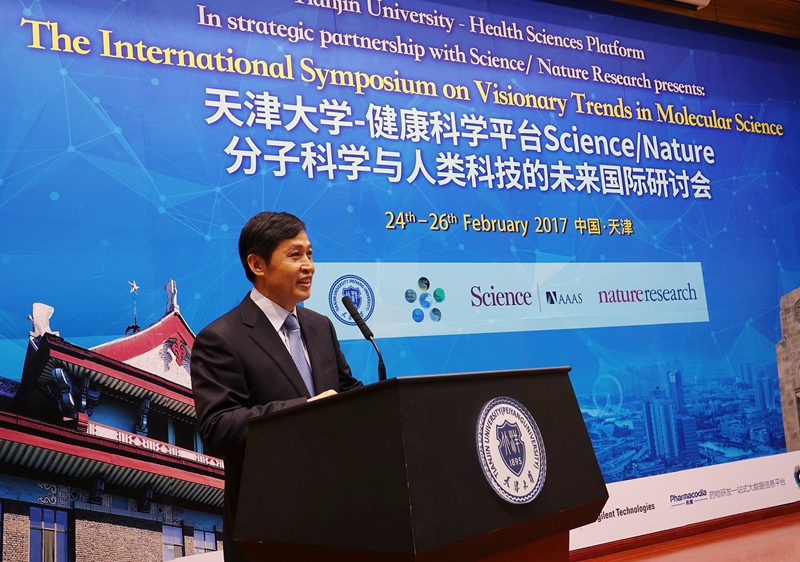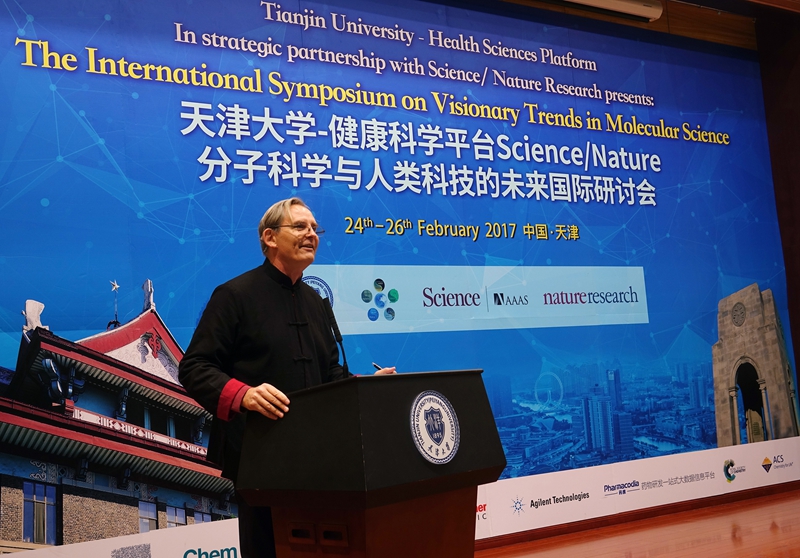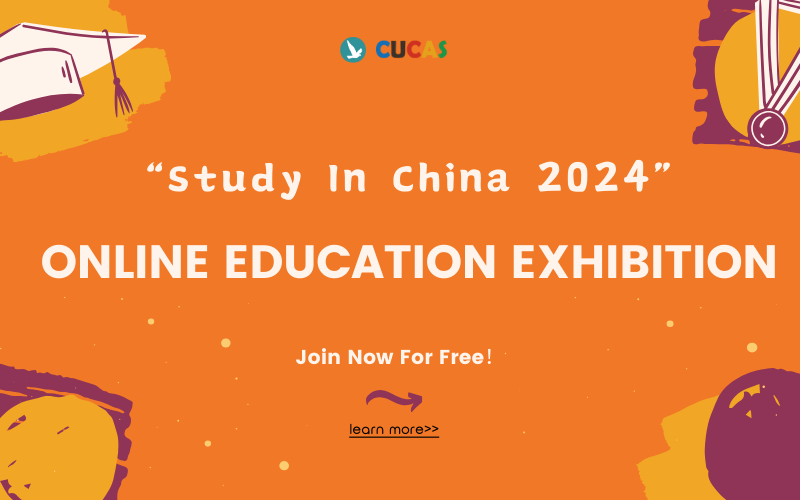“Functional Polymer Materials Designed for Environmental Remediation and Sustainability”, “DNA Nanostructures for Cellular Delivery of Therapeutics”, “Complex Natural Product Synthesis” These intriguing topics surrounding human life, environment, and health, while these cutting-edge scientific and technological developments fall in the sphere of Molecular Science. Molecular science is a comparatively recent field of research encompassing biochemistry, molecular chemistry, medicine, and pharmacy and is transforming our future lives.
The International Symposium on Visionary Trends in Molecular Science was held from Feb 24th to 26th in the Science Library of Tianjin University (TJU). This symposium, aims to promote academic research and education in Molecular Science, is organized by the Health Science Platform of TJU. The symposium was held in strategic partnership with Science and Nature, and sponsored by world well known magazines and institutes including Cell, JACS, CHEM, Elsevier, Thermofisher, Agilent, Pharmacodia, RSC, ACS, etc., Not only top scientists in the molecular science field, such as Nobel Laureates and distinguished professors, but also students from prestigious domestic universities attended the symposium.

Hundreds well-known scholars and experts from 17 countries attended the International Symposium on Visionary Trends in Molecular Science
This remarkable symposium brought together leading academic scientists, researchers and research scholars to exchange and share their experiences and research results on all aspects of Molecular Science. It also provides a premier interdisciplinary platform for researchers, practitioners and educators to present and discuss the most recent innovations, trends, and concerns as well as practical challenges encountered and solutions adopted in the fields of Molecular Science.
Zhong Denghua, president of TJU delivered an opening speech to welcome the Nobel Laureates and hundreds well-known scholars and experts from 17 countries. He gave a brief introduction to Tianjin University, focusing on SPST for the exemplary and leading role it played in progressing toward internationalization. Hu Wenping vice president of Tianjin University attended the symposium.

Zhong Denghua, president of TJU delivered an opening speech
Jay Steven Siegel, Dean of Health Science Platform of TJU, hosted the opening ceremony. He also extended his welcome to guests and introduced the Tianjin University Health Sciences Platform which is currently under construction. This platform contains Molecular Medicine, Life Sciences, Bioinformatics, Biological Engineering, and Pharmacy Management. It aims to build up a complete international talent development scheme.

Jay Steven Siegel extended his welcome to guests and introduced the Tianjin University Health Sciences Platform
As the first speaker, Professor Makoto Fujita delivered a presentation about coordination self-assembly, which consists of two parts, crystalline sponges and molecular cages. Professor Fujita has made significant contributions to the field of porous coordination networks. The binding of organic guests in the pores, was applied to a new technique, the “crystalline sponge method” that does not require the crystallization of samples. Furthermore, Fujita showed us a beautiful molecular structure based on his theoretical calculations.
Tang Benzhong, an academician of the Chinese Academy of Sciences, delivered a presentation in material field. His topic was “AIEgens: Aggregate Molecules that Make the Invisible Visible”. Research on aggregation-induced emission (AIE) has been a hot topic in the field recently. Due to the enthusiastic effort of many researchers, hundreds of AIE luminogens (AIEgens) have been generated which were mainly based on archetypal silole, tetraphenylethene, distyrylanthracene, triphenylethene, and tetraphenyl-1,4-butadiene, etc. To enlarge the family of AIEgens and to enrich their functions, new AIEgens are in high demand. A series of AIE luminogens based on imidazole-cored molecular rotors have been designed and synthesized by Tang. Due to the antifungal characteristics of imidazole moiety, the imidazole derivatives are demonstrated for the inhibition of yeast growth and the evaluation of antifungal activity. According to Tang, AIEgens have special application value in medical diagnosis and treatment which will greatly improve our lives.
Han Zuilhof, an editor of Langmuir then gave a speech titled “Throwing DARTs at Surfaces: A New Entry into Surface-Bound Organic Chemistry”. Professor Han told us that the modification of surfaces with covalently attached organic monolayers provides a highly flexible route to obtain a surface with controllable surface properties. He proposed a simple reaction set-up in combination with a generally applicable surface modification strategy and an atmospheric mass spectrometric surface analysis (so-called: DART, i.e. Direct Analysis in Time) to obtain both quantitative and structural information on how, and how much of, a moiety is attached onto a monolayer. His prospective advancements are bright and promising.
Tian He an academician of the Chinese Academy of Sciences, discussed Color-tunable Fluorescence of Single Phenazine Molecule via Vibration Induced Emission (VIE). In pursuit of design and modification of photophysical properties on the molecular level, N,N′-disubstituted-dihydrodibenzo[a,c]phenazines were demonstrated as a vivid example of elaborate manipulation via VIE, which is coined for this particular change in configuration and planarity motion.
Hanadi Sleiman, Professor of Chemistry and Canada Research Chair in DNA Nanoscience at McGill University, delivered a speech named “DNA Nanostructures for Cellular Delivery of Therapeutics”. In her presentation, discussions were divided mainly into two aspects: DNA nanostructures for cellular delivery of therapeutics, and the function of DNA as molecular imprinting. Prof. Sleiman mentioned that the shape and size of nanomaterials determines the rate of diffusion, cell localization, toxicity, and immune response, etc. She also introduced the three main types of DNA molecules and the important role of Target Ligand in cell recognition. Also Professor Thomas Meade gave a presentation about his research in Coordination Chemistry and Molecular Imaging. In order to facilitate the audience, he used animation to clarify the process where DNA and protein in vivo were tested through Coordination Chemistry and Molecular Imaging. He also introduced various fields in which this technique was widely applied, including monitoring gene expression, probing the area of development, and more.
Later, Professor Keisuke Suzuki of the Tokyo Institute of Technology introduced the synthesis of natural products, taking the assembly of Polyketide as an example. In the speech, theoretical and experimental analyses were performed to demonstrate the synthesis of Polyketide Type II, which played an important role in the development of antibiotics.
Professor Guo Xuefeng, Professor Subi Jacob George, and Professor Karen Wooley, all outstanding in the field of Molecular Science, delivered their speeches on molecular and polymer materials. Guo Xuefeng, professor of Peking University, presented his findings on Carbon Electrode-Molecule Junctions, making a great contribution to improving the property of electronics. Prof. Subi Jacob George, a young associate of the Indian Academy of Sciences, Asian Photochemistry Association, on the Editorial Advisory Board of Chemistry of Materials, and works in New Chemistry Unit of Jawaharlal Nehru Centre for Advanced Scientific Research (JNCASR). His speech focused on Fuel-Driven Temporal Control on Supramolecular Assemblies, which helps mankind better understand the process of biological change. Karen Wooley, Professor of Texas A&M University, concentrated on Functional Polymer Materials Designed for Environmental Remediation and Sustainability. She explained that “through magnetic attraction, this material can gather and absorb a large amount of oil contaminants in the water so that the water is purified.” Based on their results, a new material, MHNs, was designed by her team. The new material, which is made from carbohydrate, is eco-friendly, and has great significance for the protection of the environment.
Professor Liu Yunqi, an Academician of the Institute of Chemistry, Chinese Academy of Sciences (CAS), introduced his research regarding strong stability materials and field effect transistors. Prof. Stefan Bernhard, from Carnegie Mellon University, started his speech with a joke: “The molecules I’ve studied are not as complicated as those mentioned by the professors before me. They are simple but of high efficiency.” His research combined water decomposition with solar energy. He gave a brief introduction to the research history in this field. Then, specific principles were pulled in. In the end, he summarized the work he has completed. “Though there remains a lot to be improved” he said, “It will be a success and benefit for human beings someday”.
From Feb. 24th to Feb. 26th, three precious days witnessed an unprecedented scientific feast. 28 distinguished professors and scientists from all over the world brought their prominent research of Molecular Science to TJU. It is not only a milestone in science, but also a breakthrough for the bright future of human kind.
Original Article From: http://www.tju.edu.cn/english/News/Latest_News.htm
Learn More and Apply: Tianjin University




















